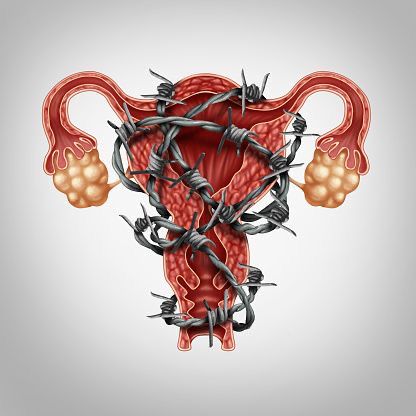Understanding Endometriosis: What Every Woman Should Know

Endometriosis is one of the most misunderstood and underdiagnosed conditions affecting women today. Despite affecting 1 in 10 women of reproductive age worldwide, awareness remains low, especially in many African communities, including Nigeria. For many, the pain is dismissed as “normal period pain,” leaving them to suffer in silence.
Let’s change that by shining a light on what endometriosis is, its symptoms, causes, management options, and how nutrition plays a role in supporting overall wellness.
What Is Endometriosis?
Endometriosis is a condition where tissue similar to the lining of the uterus (endometrium) grows outside the uterus, often on the ovaries, fallopian tubes, pelvic walls, or even the bladder and intestines.
These tissues respond to hormonal changes during the menstrual cycle — they thicken, break down, and bleed. But unlike menstrual blood that exits the body during a period, this blood has nowhere to go. This leads to inflammation, pain, scar tissue, and sometimes fertility issues.
Common Symptoms of Endometriosis
Symptoms can vary widely — some women have severe pain; others may not even realise they have it. Common signs include:
Painful periods (dysmenorrhea) — intense cramping not relieved by regular painkillers
Chronic pelvic pain
Pain during or after sex
Painful bowel movements or urination during menstruation
Heavy bleeding (menorrhagia) or bleeding between periods
Fatigue
Bloating and digestive problems
Difficulty getting pregnant
It’s important to note that painful periods are not always normal; persistent or severe pain should be investigated.
What Causes Endometriosis?
The exact cause is still unclear, but some theories include:
Retrograde menstruation: Menstrual blood flows backward into the pelvis instead of exiting through the vagina.
Hormonal imbalances: Especially excess estrogen.
Immune system disorders that prevent the body from destroying misplaced tissue.
Genetics: Having a close relative with endometriosis increases risk.
Environmental toxins like dioxins may also play a role.
How Is Endometriosis Diagnosed?
Diagnosis can be tricky. Many women go 7–10 years without a correct diagnosis. A combination of the following is often used:
Medical history and symptoms
Pelvic exams
Ultrasound or MRI
Laparoscopy (keyhole surgery) – the gold standard for confirming diagnosis
Treatment and Management
There is no known cure, but several treatments can manage symptoms and improve quality of life:
1. Pain Management
NSAIDs (e.g., ibuprofen) for mild pain
Hormonal treatments (e.g., birth control pills, IUDs, GnRH agonists) to reduce hormone levels
Surgery to remove or burn endometrial tissue
2. Lifestyle & Nutrition Support
Anti-inflammatory diets
Stress management
Regular exercise
Adequate sleep
3. Fertility Treatment
If endometriosis causes infertility, assisted reproductive technologies like IVF may help.
Nutrition and Endometriosis: Food as Support
While food cannot cure endometriosis, a balanced, anti-inflammatory diet may help reduce pain, support hormone balance, and improve energy.
Anti-Inflammatory Foods to Include:
Leafy greens like ugu, bitter leaf, and spinach
Fruits such as pineapple, oranges, and watermelon
Whole grains like millet, guinea corn, oats
Healthy fats from avocados, nuts, egusi, flaxseeds
Omega-3 rich fish like mackerel (Titus), sardines
Spices like turmeric and ginger — natural anti-inflammatories
Herbal teas (e.g., zobo made with hibiscus petals and ginger, without sugar)
Foods to Limit or Avoid:
Red meat (especially processed)
Excess dairy (for some individuals)
Refined sugars and sugary drinks
Fried and fast foods
Excess caffeine and alcohol
Tip: Keeping a food and symptom journal can help identify personal triggers.
Endometriosis and Mental Health
Living with chronic pain and fertility issues can lead to anxiety, depression, and isolation. That’s why emotional support is just as important. Women with endometriosis need:
Safe spaces to share their experiences
Supportive healthcare professionals
Mental health care when needed
A community that understands
At TGNC, we advocate for compassionate care, awareness, and education. No woman should be left to suffer in silence.
When to Seek Help
You don’t need to have all the symptoms to speak to a healthcare provider. See a doctor if:
Period pain interferes with school, work, or everyday activities
You’ve been trying to conceive for a year without success
You have persistent pelvic pain, bloating, or fatigue
You feel dismissed or misunderstood — seek a second opinion if necessary
Final Thoughts
Endometriosis is real, painful, and often invisible — but it is not unbeatable. With the right combination of medical care, nutrition, and support, women can live healthy, fulfilling lives despite the condition.
Let’s break the silence. Let’s raise awareness. Let’s support one another.
💛 Join the TGNC Community Today
We’re committed to educating, supporting, and empowering women and nutrition professionals to better understand conditions like endometriosis and how to manage them holistically. Follow us for more health tips, expert insights, and free resources.

